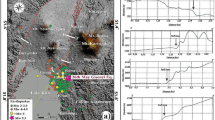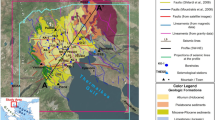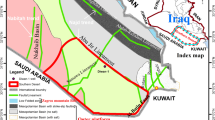Abstract
Compressional region usually forms complex thrust faults system, which is difficult to identify using traditional migration profiles. The successful application of three-dimensional (3D) seismic attributes analysis greatly reduces the difficulty, and improves the accuracy and efficiency of seismic interpretation and structural analysis. In this paper, we took Qiongxi area in the compressional region of western Sichuan as an example, using two 3D seismic attributes, coherence and instantaneous phase, to identify fault assemblages and variations both vertically and laterally. The results show that the study area mainly consists of NS-, NE- and NEE-trending faults. The NS-trending faults are the largest and have a component of sinistral slip controlling the formation of NEE-trending faults, while the NE-trending faults are intermediate in scale, formed earlier and were cut by the NS-trending faults. Our results demonstrate that using seismic attributes for structural analysis have the following advantages: (1) more details of major fault zones, (2) highlighting minor faults which are hardly traced in seismic migration cube, and (3) easier acquisition of accurate fault systems. The application of seismic attributes provides a new idea for deciphering fine and complicated structures, and will significantly contribute to the development of objective and precise geological interpretation in the future.
Similar content being viewed by others
References Cited
Bahorich, M., Farmer, S., 1995. 3-D Seismic Discontinuity for Faults and Stratigraphic Features: The Coherence Cube. The Leading Edge, 14(10): 1053–1058. doi:10.1190/1.1437077
Barnes, A. E., 1992. The Calculation of Instantaneous Frequency and Instantaneous Bandwidth. Geophysics, 57(11): 1520–1524. doi:10.1190/1.1443220
Cartwright, J., Huuse, M., 2005. 3D Seismic Technology: The Geological ‘Hubble’. Basin Research, 17(1): 1–20. doi:10.1111/j.1365-2117.2005.00252.x
Chen, Q., Sidney, S., 1997. Seismic Attribute Technology for Reservoir Forecasting and Monitoring. The Leading Edge, 16(5): 445–456. doi:10.1190/1.1437657
Chopra, S., Marfurt, K. J., 2005. Seismic Attributes—A Historical Perspective. Geophysics, 70(5): 350–2850. doi:10.1190/1.2098670
Chopra, S., Misra, S., Marfurt, K. J., 2011. Coherence and Curvature Attributes on Preconditioned Seismic Data. The Leading Edge, 30(4): 386–393. doi:10.1190/1.3575281
Eastwood, J., 2002. The Attribute Explosion. The Leading Edge, 21(10): 994. doi:10.1190/1.1518435
Fomel, S., 2007. Local Seismic Attributes. Geophysics, 72(3): A29–A33. doi:10.1190/1.2437573
Han, X., Gao, X. Y., Che, T. X., et al., 2007. Using Analysis of Seismic Attributes along Horizons to Study Sedimentary Environment of Fluvial Facies. Oil Geophysical Prospecting, 42(1): 120–123 (in Chinese)
Hart, B. S., 1999. Definition of Subsurface Stratigraphy, Structure and Rock Properties from 3-D Seismic Data. Earth Science Reviews, 47: 189–218. doi:10.1016/S0012-8252(99)00029-X
He, D. F., Li, D. S., Zhang, G. W., et al., 2011. Formation and Evolution of Multi-Cycle Superposed Sichuan Basin, China. Chinese Journal of Geology, 46(3): 589–606 (in Chinese with English Abstract)
Heggland, R., 1997. Detection of Gas Migration from a Deep Source by the Use of Exploration 3D Seismic Data. Marine Geology, 137: 41–47. doi:10.1016/S0025-3227(96)00077-1
Iacopini, D., Butler, R. W. H., 2011. Imaging Deformation in Submarine Thrust Belts Using Seismic Attributes. Earth and Planetary Science Letters, 302: 414–422. doi:10.1016/j.epsl.2010.12.041
Jia, D., Li, Y. Q., Wang, M. M., et al., 2011. Three-Dimensional Structural Geometry of Fault-Related Folds: Examples from 3-D Seismic Explored Blocks in the Western Sichuan Province, China. Acta Petrologica Sinica, 27(3): 732–740 (in Chinese with English Abstract)
Jia, D., Wei, G. Q., Chen, Z. X., et al., 2006. Longmen Shan Fold-Thrust Belt and Its Relation to the Western Sichuan Basin in Central China: New Insights from Hydrocarbon Exploration. AAPG Bulletin, 90(9): 1425–1447. doi:10.1306/03230605076
Jia, Q. P., Jia, D., Liang, L., et al., 2009. Three-Dimensional Evolutionary Models of the Qiongxi Structures, Southwestern Sichuan Basin, China: Evidence from Seismic Interpretation and Geomorphology. Aata Geologica Sinica, 83(2): 372–385. doi:10.1111/j.1755-6724.2009.00038.X
Li, Z. W., Liu, S. G., Lin, J., et al., 2009. Structural Configuration and its Genetic Mechanism of the West Sichuan Depression in China. Journal of Chengdu University of Technology (Science & Technology Edition), 36(6): 645–653 (in Chinese with English Abstract)
Liu, S. G., Deng, B., Li, Z. W., et al., 2013. Geological Evolution of the Longmenshan Intracontinental Composite Orogen and the Eastern Margin of the Tibetan Plateau. Journal of Earth Science, 24(6): 874–890. doi:10.1007/s12583-013-0391-5
Lü, L., Wang, M. J., Fan, J. Z., 2011. Seismic Attribute Recognition in the Application of Natural Gas Hydrate. Progress in Geophysics, 26(2): 596–601 (in Chinese with English Abstract)
Marfurt, K. J., 2006. Robust Estimates of Dip and Azimuth. Geophysics, 71(4): 29–40. doi:10.1190/1.2213049
Rooij, M., Tingdahl, K., 2002. Meta-Attributes—The Key to Multivolume, Multiattribute Interpretation. The Leading Edge, 21(10): 1050–1053. doi:10.1190/1.1518445
Sun, S. L., Wu, X. Z., 2004. Application Results of 3-D Seismic Exploration Technology in Coal Mines. Acta Geologica Sinica, 78(3): 729–735. doi:10.1111/j.1755-6724.2004.tb00189.x
Taner, M. T., Koehler, F., Sheriff, R. E., 1979. Complex Seismic Trace Analysis. Geophysics, 44(6): 1041–1063. doi:10.1190/1.1440994
Tong, D. J., Zhang, J. X., Yang, H. Z., et al., 2012. Fault System, Deformation Style and Development Mechanism of the Bachu Uplift, Tarim Basin. Journal of Earth Science, 23(4): 529–541. doi:10.1007/s12583-012-0273-2
Wang, E. Q., Meng, Q. R., Chen, Z. L., et al., 2001. Early Mesozoic Left-Lateral Movement along the Longmen Shan Fault Belt and Its Tectonic Implications. Earth Science Frontiers, 8(2): 376–384 (in Chinese with English Abstract)
Wang, M. M., Jia, D., Lin, A. M., et al., 2013a. Late Holocene Activity and Historical Earthquakes of the Qiongxi Thrust Fault System in the Southern Longmen Shan Fold-and-Thrust Belt, Eastern Tibetan Plateau. Tectonophysics, 584: 102–113. doi:10.1016/j.tecto.2012.08.019
Wang, M. M., Jia, D., Shaw, J. H., et al., 2013b. Active Fault-Related Folding Beneath the Alluvial Terrace in the South Longmen Shan Range Front, Sichuan Basin, China: Implications for Seismic Hazard. Bulletin of the Seismological Society of America, 103(4): 2369–2385
Wu, S. X., Wang, Z. C., Zhang, L., et al., 2001. Exploration Strategy for the Foreland Basin in Western Sichuan. Oil & Gas Geology, 22(3): 210–216 (in Chinese with English Abstract)
Zhang, Y. L., Xiao, G. J., 2010. Research and Application of Seismic Attributions of Formation Lithology Hydrocarbon Reservoirs—In the Yong 1 Area as an Example. Progress in Geophysics, 25(4): 1332–1338 (in Chinese with English Abstract)
Zhang, Y. Z., Li, S. E., Huang, G. P., et al., 2002. The Classification and Application Value of Seismic Slice. Petroleum Geology and Recovery Efficiency, 9(3): 67–70 (in Chinese with English Abstract)
Zhong, K., Xu, M. J., Wang, L. S., et al., 2004. Geophysical Evidences of Two-Segment Tectonic Evolution of Two-Phase Foreland Basin in the Western Sichuan Province. Acta Petrolei Sinica, 25(6): 29–37 (in Chinese with English Abstract)
Author information
Authors and Affiliations
Corresponding author
Rights and permissions
About this article
Cite this article
Xu, B., Xiao, A., Wu, L. et al. 3D seismic attributes for structural analysis in compressional context: A case study from western Sichuan Basin. J. Earth Sci. 25, 985–990 (2014). https://doi.org/10.1007/s12583-014-0497-4
Received:
Accepted:
Published:
Issue Date:
DOI: https://doi.org/10.1007/s12583-014-0497-4




